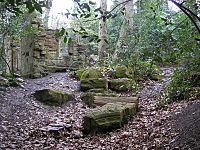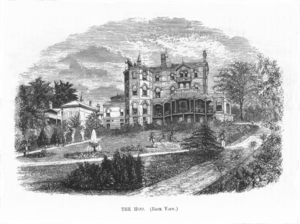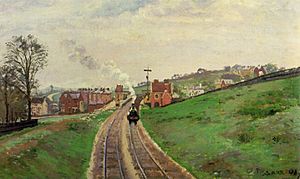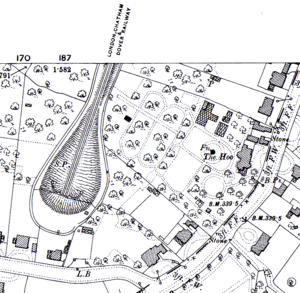Sydenham Hill Wood facts for kids
Quick facts for kids Sydenham Hill Wood |
|
|---|---|

The folly, a rockery and the path of a former ornamental stream.
|
|
| Type | Woodland |
| Location | Sydenham Hill, Sydenham, London |
| Operated by | Dulwich Estate London Borough of Southwark |
| Public transit access | Sydenham Hill railway station |
Sydenham Hill Wood is a special ten-hectare forest in South London. It sits on the northern side of the Norwood Ridge in the London Borough of Southwark. This amazing place is known as a Local Nature Reserve. It is also a very important spot for nature in London.
Sydenham Hill Wood and the nearby Dulwich Wood are the biggest parts left of an old forest called the Great North Wood. These woods were once smaller areas. They grew bigger after the Crystal Palace moved in 1854. Also, a new railway line was built in 1865.
The land belongs to the Dulwich Estate. It is rented to Southwark Council. Southwark Council then rents Sydenham Hill Wood to the London Wildlife Trust. This means the London Wildlife Trust helps look after the wood. In 1997, Sydenham Hill Wood won an award for being a great urban wildlife spot. People often have special days to help care for the wood. They also hold events to learn about its wildlife.
Contents
History of Sydenham Hill Wood
In the 1500s, the woods on Sydenham Hill were very important. Elizabeth I, the Queen, kept them special. She used the trees to get wood for building ships.
Cox's Walk: An Old Path
A straight path lined with oak trees is called Cox's Walk. It was made around 1732 by Francis Cox. He wanted to connect his tavern, the Green Man, and some wells in Dulwich. This path led to the more popular Sydenham Wells.
Many years later, a famous poet named Thomas Campbell lived in Sydenham. He often walked to visit his friend, Dr. Glennie, in Dulwich Grove.
Grand Houses and a Folly
After the Crystal Palace moved in 1854, many large houses were built along Sydenham Hill. One of the biggest was called The Hoo. It stood near where 36 Sydenham Hill is today.
The interesting stone structure called a folly was in the garden of a house named Fairwood. This house was at 53 Sydenham Hill. The owner, Alderman David Henry Stone, asked James Pulham & Son to build the folly. This company was known for building cool garden features. They also worked on the bridge in Buckingham Palace Gardens.
The Crystal Palace Railway
The Crystal Palace and South London Junction Railway used to run through Sydenham Hill Wood. It opened on August 1, 1865. The railway went through two tunnels and ended near the Crystal Palace.
In 1871, a famous painter named Camille Pissarro painted a picture of the railway. It showed a train blowing steam as it went down the tracks. This painting showed the excitement of the Industrial Revolution. The railway became less popular after the Crystal Palace burned down in 1936. It closed for good in 1954. The tracks were removed in 1956.
Saving the Wood for Nature
In 1982, Southwark Council let the London Wildlife Trust manage the wood. They wanted it to be a nature reserve. But in 1984, there were plans to build many flats on part of the wood.
The London Wildlife Trust and local people started a "Save the Woods" campaign. Many people wrote letters and spoke up. They wanted to protect the wood. A public meeting was held. Many people talked about how important the wood was for wildlife and for learning.
In July 1985, an official report said that most of the wood should be protected. This was a big win for the "Save the Woods" campaign. It helped make sure that this special place would stay wild.
What You Can See Today
Today, you can still find many interesting things in the wood. There are still some rhododendrons. You might also spot a lone monkey puzzle tree or a cedar of Lebanon. Parts of the old railway track have gone back to nature. You can follow the path of the old railway from the footbridge on Cox's Walk. It leads to the entrance of the Crescent Wood tunnel.
There is also a small stream in the woods called the Ambrook. It used to flow into the River Effra. Now, it flows across a golf course and then into the lake in Dulwich Park.
Wildlife in Sydenham Hill Wood
Sydenham Hill Wood is a mix of old forest, plants from old gardens, and newer woodland. It is one of the oldest woods close to central London. It is home to over 200 types of trees and flowering plants. You can also find many fungi, rare insects, birds, and shy woodland animals. These include the Wood mouse and the hedgehog.
Trees and Plants
The wood is mostly made up of sessile oak and hornbeam trees. But it also has many other kinds of trees and bushes. Some of these are unusual plants that were planted when the wood was part of large gardens. You can find plants that show the wood has been there for a long time. These include ramsons (Allium ursinum), wood anemone (Anemone nemorosa), wood sorrel, and hairy wood-rush (Luzula pilosa).
Birds and Insects
Two types of British woodpeckers live and breed here. You might also see nuthatches, treecreepers, and tawny owls. Birds like the kestrel and sparrowhawk also live here. In 2015, a hobby bird even nested in the wood.
Many insects have been recorded here. These include beautiful butterflies like the purple hairstreak, white-letter hairstreak, and speckled wood. There are also several rare bees and wasps, and even stag beetles.
Ponds and Bats
There is one small pond in Sydenham Hill Wood. Volunteers help to check on it. You can find common frogs and smooth newts living there. Dragonflies like the southern hawker and damselflies like the common blue also visit the pond.
Several types of bats use the wood. These include the common and soprano pipistrelle bats. You might also find noctule, Leisler, and brown long-eared bats. Sydenham Hill Wood is the only place in Southwark where brown long-eared bats have been seen!
How to Visit Sydenham Hill Wood
There is a map and a special trail with numbers to guide you. You can start from the entrance on Crescent Wood, which is off Sydenham Hill. There is another entrance by the footbridge on Cox's Walk.
Getting There by Public Transport
To reach the Crescent Wood entrance by bus, you can take bus 356. Get off at the 'Crescent Wood Road' stop. This bus comes from Forest Hill station. Buses on route 363 from Crystal Palace also stop near this entrance.
You can also get to the wood from Sydenham Hill railway station. From the station, cross the road and go through the white gate into Low Cross Wood Lane. On your left, you will see a gate to Dulwich Wood. Follow the path straight ahead in Dulwich Wood. Turn right just before the pond. This will lead you close to the Crescent Wood tunnel in Sydenham Hill Wood.
If the gate into Dulwich Wood is locked, follow the lane that goes steeply uphill onto Crescent Wood Road. Turn left at the top. Following this road will bring you to the Crescent Wood Road entrance of Sydenham Hill Wood.





